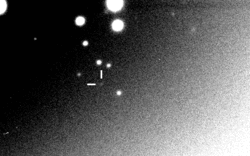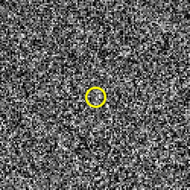Astronomy:Praxidike (moon)
 Praxidike imaged by the Canada-France-Hawaii Telescope in December 2001 | |
| Discovery[1] | |
|---|---|
| Discovered by | Scott S. Sheppard et al. |
| Discovery site | Mauna Kea Obs. |
| Discovery date | 23 November 2000 |
| Designations | |
Designation | Jupiter XXVII |
| Pronunciation | /prækˈsɪdəkiː/[2] |
| Named after | Πραξιδίκη Praxidikē |
| S/2000 J 7 | |
| Adjectives | Praxidikean /ˌpræksədəˈkiːən/[3] |
| Orbital characteristics [5] | |
| 21147000 km | |
| Eccentricity | 0.230 |
| Orbital period | −609.25 days[4] |
| Mean anomaly | 21.8° |
| Inclination | 149.0° |
| Longitude of ascending node | 285.2° |
| 209.7° | |
| Satellite of | Jupiter |
| Group | Ananke group |
| Physical characteristics | |
| Mean diameter | 7.0±0.7 km[6] |
| Albedo | 0.029±0.006[6] |
| Apparent magnitude | 21.2 |
Praxidike /prækˈsɪdəkiː/, also known as Jupiter XXVII, is a retrograde irregular satellite of Jupiter. It was discovered by a team of astronomers from the University of Hawaii led by Scott S. Sheppard in 2000,[7][1] and given the temporary designation S/2000 J 7.
It was named in August 2003 after Praxidike,[8] the Greek goddess of punishment.
Orbit

Praxidike orbits Jupiter at an average distance of 20,824,000 km in 609.25 days, at an inclination of 144° to the ecliptic (143° to Jupiter's equator), in a retrograde direction and with an eccentricity of 0.1840.
Praxidike belongs to the Ananke group, believed to be the remnants of a break-up of a captured heliocentric asteroid.[9][10] With an estimated diameter of 7 km, Praxidike is the second largest member of the group after Ananke itself (assumed albedo of 0.04).[11]
Characteristics
The satellite appears grey (colour indices B-V=0.77, R-V= 0.34), typical of C-type asteroids.[12]
References
- ↑ 1.0 1.1 MPEC 2001-A29: S/2000 J 7, S/2000 J 8, S/2000 J 9, S/2000 J 10, S/2000 J 11 January 15, 2001 (discovery and ephemeris)
- ↑ as 'Praxidice' in Noah Webster (1884) A Practical Dictionary of the English Language
- ↑ There is also 'Praxidician' /præksəˈdɪʃiən/, as in the 'Praxidician goddesses' that include Praxidice, but this does not derive from the name Praxidice itself.
- ↑ "M.P.C. 104798". Minor Planet Circular. Minor Planet Center. 10 May 2017. https://minorplanetcenter.net/iau/ECS/MPCArchive/2017/MPC_20170510.pdf.
- ↑ S.S. Sheppard (2019), Moons of Jupiter, Carnegie Science, on line
- ↑ 6.0 6.1 Grav, T.Expression error: Unrecognized word "etal". (August 2015). "NEOWISE: Observations of the Irregular Satellites of Jupiter and Saturn". The Astrophysical Journal 809 (1): 9. doi:10.1088/0004-637X/809/1/3. 3. Bibcode: 2015ApJ...809....3G. https://authors.library.caltech.edu/61254/1/Grav_2015.pdf.
- ↑ IAUC 7555: Satellites of Jupiter January 5, 2001 (discovery)
- ↑ IAUC 7998: Satellites of Jupiter 2002 October 22 (naming the moon)
- ↑ Sheppard, S. S., Jewitt, D. C.; An Abundant Population of Small Irregular Satellites Around Jupiter , Nature, Vol. 423 (May 2003), pp. 261-263
- ↑ Nesvorný, D.; Alvarellos, J. L. A.; Dones, L.; and Levison, H. F.; Orbital and Collisional Evolution of the Irregular Satellites, The Astronomical Journal, Vol. 126 (2003), pp. 398–429
- ↑ Sheppard, S. S.; Jewitt, D. C.; Porco, C.; Jupiter's Outer Satellites and Trojans , in Jupiter: The Planet, Satellites and Magnetosphere, edited by Fran Bagenal, Timothy E. Dowling, and William B. McKinnon, Cambridge Planetary Science, Vol. 1, Cambridge, UK: Cambridge University Press, ISBN:0-521-81808-7, 2004, pp. 263-280
- ↑ Grav, T.; Holman, M. J.; Gladman, B. J.; Aksnes, K.; Photometric Survey of the Irregular Satellites, Icarus, Vol. 166 (2003), pp. 33-45
- Ephemeris IAU-MPC NSES
- Mean orbital parameters NASA JPL
External links
 |

